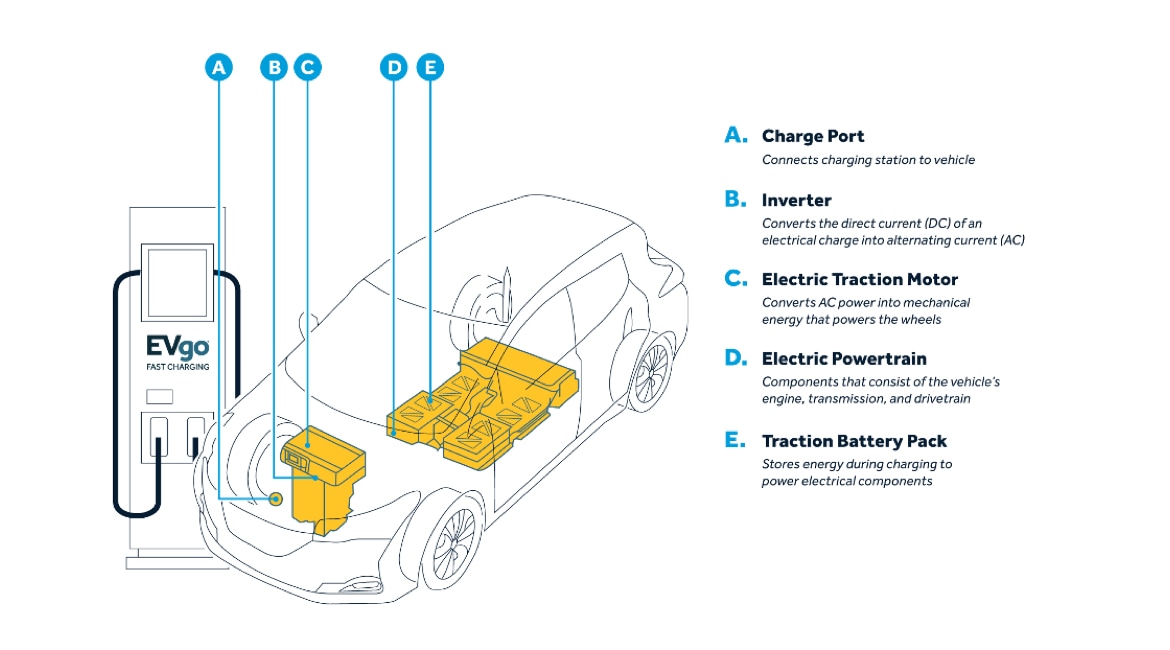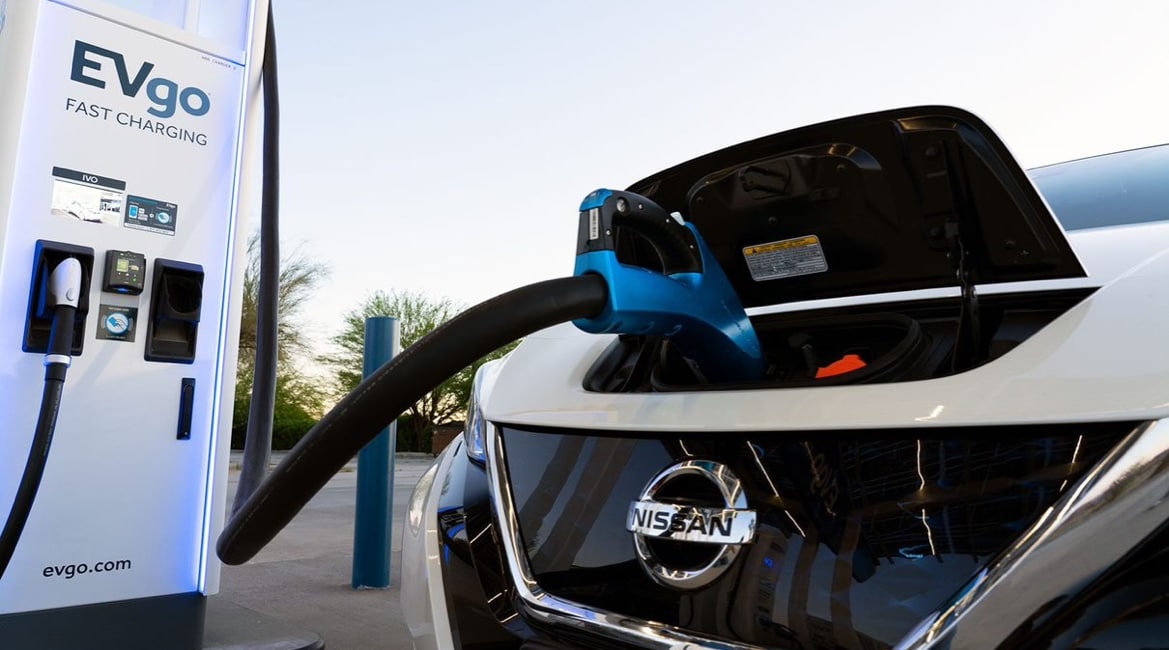Nissan parts online, Nissan parts near me. Nissan oem parts
How electric Car works
Unlike gas-powered vehicles, electric vehicles (EVs) do not require internal combustion engines to operate. Outfitted with an electric motor and rechargeable battery pack, EVs move along our roadways without burning up gasoline, or producing harmful exhaust emissions, while generating less noise pollution.
Here’s a basic rundown of how electric cars work: EVs receive energy from a charging station and store the energy in its battery. The battery gives power to the motor which moves the wheels. Many electrical parts work together in the background to make this motion happen.
Key Components of an Electric Car
Breaking down the key parts that make up an electric car is essential to understanding how they run. These key components include:

Charge Port
An electric vehicle’s charge port allows the battery pack to receive energy from an external power source. These power sources are referred to as electric vehicle supply equipment (EVSE), more commonly known as a charging station.
Charging occurs when an EVSE is plugged into an EV’s charge port at a private residence or commercial charging station [*]
. For example, an EVSE that utilizes a standard 240-volt outlet (similar to those used for household appliances) can charge an EV overnight. [*]
Inverter
Electric vehicle inverters change the battery pack’s flow of electrons from a Direct Current (DC) into an AC, which is then used to power the electric traction motor. Because lithium-ion batteries can only accept DC power — and because electric traction motors require AC power to function — inverters are necessary components for EVs. Inverters are also used to control the frequency of the AC power being sent to the motor, so they play a direct role in controlling an EV’s speed.

Electric Traction Motor
Receiving electricity from the inverter, the electric traction motor provides the power that makes an electric vehicle move. Electric traction motors are commonly powered by an alternating current, as this type of motor is more efficient and reliable than a DC motor. When AC electrons reach the motor via the inverter, they generate a rotating magnetic field that causes the motor to turn. Electric traction motors are highly efficient and powerful, as they do not feature multiple gears to shift between like an internal combustion engine — power from the pedal to the engine is almost immediate.
Traction Battery Pack
An electric vehicle’s traction battery pack’s main function is to store energy gathered from the grid during charging. This energy is then used to power the vehicle’s motor and all other electrical components.
Almost all EVs on the road today utilize Lithium on Battery within their traction battery pack, as they have one of the highest energy densities of any battery available. Lithium-ion batteries also produce larger currents and require little maintenance compared to other battery types. Some EVs also feature an auxiliary battery that strictly powers vehicle accessories rather than drawing from the traction battery pack to power all components.
Electric Powertrain
An electric vehicle’s powertrain encompasses the entire high voltage electrical system that allows the vehicle to operate. An electric powertrain is commonly made up of an inverter, electric traction motor, reduction drive, and the traction battery.
Types of Electric Cars
Modern car manufacturers design different types of electric vehicles to provide drivers with a range of features and varying benefits. The most common types of EVs include:
Battery Electric Vehicles (BEV)
A battery electric vehicle (BEV) is a type of electric vehicle that is powered solely from a battery pack. BEVs do not utilize internal combustion engines or gasoline to operate, so they do not produce harmful tailpipe emissions. These vehicles receive all their energy from EVSEs that draw electricity from the grid. Nissan LEAF is a Battery Electric Vehicle.
Hybrid Electric Vehicles (HEV)
A hybrid electric vehicle (HEV) is a low-emission vehicle that utilizes a small battery pack to assist an internal combustion engine. These vehicles receive the majority of their power from gas and cannot be plugged in to charge. Instead, their battery packs are charged through regenerative braking and using a generator connected to the gas engine. Although HEV’s can’t run solely on electric power, they maximize fuel economy by allowing the use of a high efficiency, lower power gasoline engine and running that engine in a more efficient way and only turning it on when necessary.
Plug-In Hybrid Vehicles (PHEV)
A plug-in hybrid vehicle (PHEV) features both an electric traction motor and an internal combustion engine, which means they require EVSE charging and gasoline to operate. A PHEV runs on electricity until its battery pack runs out of power, in which case its internal combustion engine turns on and runs on gasoline.
How to Charge an Electric Car
Charging an electric vehicle requires access to the electrical grid and can be done at home or a commercial charging station. [*]

The three main ways to charge an EV are:
- Level 1 Charging
Using a 120-volt outlet, Level 1 home charging requires no special equipment, but it provides the slowest charging cycle compared to specialty EVSEs. This charging method provides an EV with 2 to 5 miles of range each hour of charging. [*] - Level 2 Charging
Using a 220- or 240-volt outlet, Level 2 charging requires specialty equipment in home or use of a public charging station. [*] Also works for all BEVs. This EVSE is much faster than a Level 1 charger, compatible with all plug-in vehicles, and provides 10 to 25 miles of range each hour of charging. [*] - DC Fast Charging
This specialty EVSE converts AC electricity into DC electricity within the charging station, which delivers energy into an EV’s battery pack faster than Level 1 and 2 chargers. These fast-charging stations can charge a traction battery pack from 15 to 45 minutes [*] , but they are only compatible with certain plug-in vehicles. [*]
Nissan parts online, Nissan parts near me. Nissan oem parts



Auto parts
January 11, 2017Do you have Toyota parts and Nissan parts
admin
January 11, 2017We have parts for Toyota, Lexus, Infinity, Nissan, Honda, Mitsubishi, KIA, HYUNDAI, Dodge, Jeep, Mazda, Mercedes parts, Porsche, AUDI and Volkswagen in Dubai UAE.